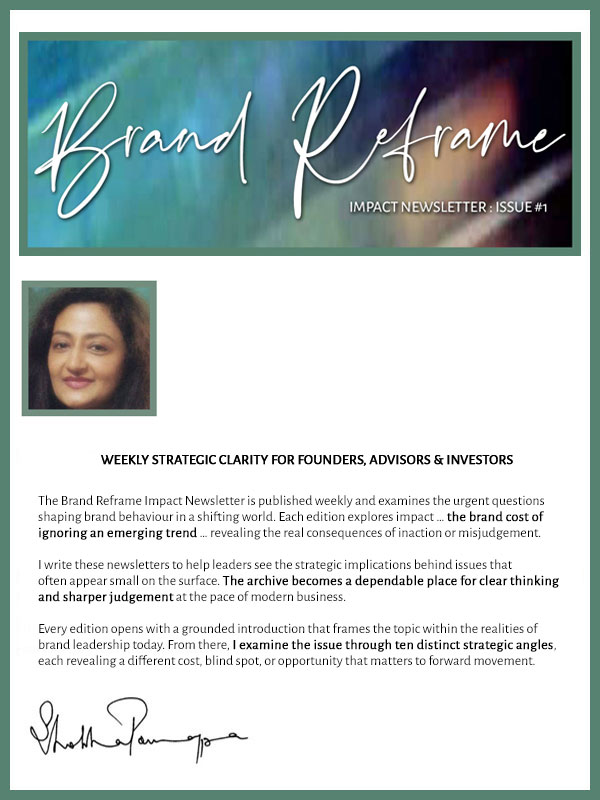
FOCUS: BRAND CLARITY ISSUES | AUDIENCE: EXPERTS WITH IGNORED BRANDS
BY: SHOBHA PONNAPPA | BRAND BREAKTHROUGH STRATEGIST | 45 YEARS | 125+ CLIENTS
I answer 6 tough questions about why a polished brand story can still confuse buyers … and how to close the clarity gaps.
I often meet expert-led brands with messaging that reads well, looks elegant, and even wins awards, yet fails to trigger action. Everything feels coherent on the surface, but buyers cannot explain what sets the offer apart or why it matters now. A complete story is not always a clear one. In this post, I answer six key questions to help spot and seal the hidden narrative gaps.
Narratives often become inward-looking as teams refine them for consistency and elegance. Over time, clarity gets traded for completeness, with every idea included but no hierarchy of importance. Buyers skim and feel impressed yet unsure where to focus. A beautiful but dense narrative can mask critical proof or urgency.
The problem deepens when the story tries to satisfy all stakeholders at once … founders, investors, and internal teams. Messages become safe and consensus-driven rather than sharp and buyer-centred. This makes the narrative feel finished internally but foggy externally. Buyers need a clear hook, not a balanced committee output.
I watch for buyer hesitation during first calls or demos: repeated clarification questions, need for extra decks, and slow follow-ups. If buyers keep asking basic “what exactly do you do” questions, clarity gaps remain. High bounce rates on key pages and weak call-to-action clicks are also red flags. Internal pride in the deck does not equal external resonance.
Another signal is when media or analysts describe you in ways that feel off. If you often correct how others summarise your offer, your message is unclear. Likewise, when sales scripts diverge widely across reps, each one is patching the gap individually. Consistent confusion shows the story may be elegant but incomplete.
I map the narrative into three arcs: who we help, what change we enable, and why we’re uniquely able to do it now. Each arc must have one sharp, provable claim backed by evidence buyers feel. I test each claim through interviews, site recordings, and sales calls to find where comprehension drops. Places where buyers pause, ask for examples, or shift topic show weak spots.
I also check analytics: scroll depth, heatmaps, and click flow on narrative-heavy pages. If visitors skim past proof points or never click deeper into case studies, the story is not compelling enough. Surveys and exit polls help uncover which words confuse or bore. Data plus conversation creates a precise map of where to repair clarity.
I prioritise by impact: fix the entry hook and core proof first, leaving peripheral details for later. Small, sharp changes … like a stronger headline or single proof stat … often unlock more clarity than full rewrites. I then tighten transitions between sections so each idea flows to the next. Buyers should never wonder “so what?” or “what now?”
Next, I update visuals and callouts to match the refreshed message. Clear infographics and proof boxes outperform abstract imagery. I also coach teams to speak aloud the new narrative in sales or webinars before changing every page. This lets the story evolve where it matters most while staying efficient.
I show them evidence: buyer confusion transcripts, call clips, and analytics. Seeing real hesitation converts opinion to urgency. I also frame the change as sharpening, not shrinking … we are making the story easier to buy, not dumbing it down. Respect for their work remains while trimming what stalls clarity.
Another tactic is to create a long-form internal version and a shorter buyer-facing one. Stakeholders feel nothing is lost, while the market gets a cleaner message. Once revenue impact shows up, resistance usually fades. Clear results make clarity changes stick.
I track conversion rates at first key actions: sign-ups, demos booked, or proposal requests. If these move up quickly after narrative tweaks, clarity has improved. I also measure buyer recall: can prospects repeat our key value in their own words? Better recall predicts faster deal cycles.
Surveys and win/loss interviews confirm when prospects found the story simple and compelling. Analyst descriptions and media headlines should now echo your chosen framing. Finally, sales teams should deliver the story consistently without improvising. True clarity shows when buyers move faster and everyone describes you the same way.
If this resonates, your narrative might be internally complete yet externally confusing. The fix is to tighten proof and urgency so buyers know what matters instantly. Start with one clear, high-impact change and expand only if results demand. Clarity converts admiration into action.
If you’re brand owner or manager seeking stronger brand performance, this FAQ Insight Post I wrote could interest you: “FAQs: When Marketing Metrics Look Good but Sales Stall.“
If you’re an investor seeking momentum for your portfolio brands, this FAQ Insight Post I worked on may resonate: “FAQs: When Industry Respect Tops Buyer Urgency For Founders.“

"One BIG IDEA can turn brand stagnation into unstoppable movement. Spots are limited each week ... book your breakthrough session now."
Shobha Ponnappa
More Breakthrough Ideas … Case Studies & FAQs … from the Brand Clarity Issues Category
Case Studies
FAQ Insights
Download the 14-case collection and receive weekly insights to strengthen your strategic judgement.
Get my free Case Studies Compendium. Real transformations, clear strategic shifts, and practical ways brands regain traction.

You’ll also get my fortnightly Brand Reframe newsletter. with smart insights, distilled thinking, and focused ideas to help your brand.

Just fill in the form to join. Be part of our circle thriving on brand clarity, good judgement, and several game-changing tips.